INTRODUCTION
As we’ve studied American history, we’ve learned about different groups of people who have influenced our country’s past. These groups include Native Americans, immigrants, minorities fighting for equal rights, and young people. However, it’s important to remember that the people who are living today will shape the future of our country, not those who have already lived.
So, who are the American people? We are different from those who came before us, and we will continue to change in the future. It’s also important to consider how different generations within our country impact our future. A lot has changed in the past 50 years, which has affected our attitudes, willingness to take risks, and values. As we think about the future, we should reflect on who we are as a country.
A CHANGING POPULATION
The United States is the third most populated country in the world with around 331 million people in 2020, but it only makes up about 4.5% of the world’s total population. Even though the number of people in the US has more than doubled since 1950, it is still much less than China and India, which have more people than any other country.
The US is changing a lot as it grows, especially in terms of the different races and ethnicities of its people. White Americans, who have always been the largest group, are expected to become less than half of the population by 2050. This means that the US will be a country where no single group makes up more than half of the people. When this happens America will be a majority-minority country. Six states, including Hawaii, New Mexico, California, Texas, Nevada, and Maryland, are already like this.
Although there are more and more people from different ethnic and racial groups, White people will still be the majority of the elderly population. Meanwhile, the proportion of Hispanic people in the US is growing and is projected to be about 25% of the population by 2050. The other groups of people in the US are mostly staying the same, but there are more and more people who are mixed race, and they are expected to be about 20% of the population by 2050.
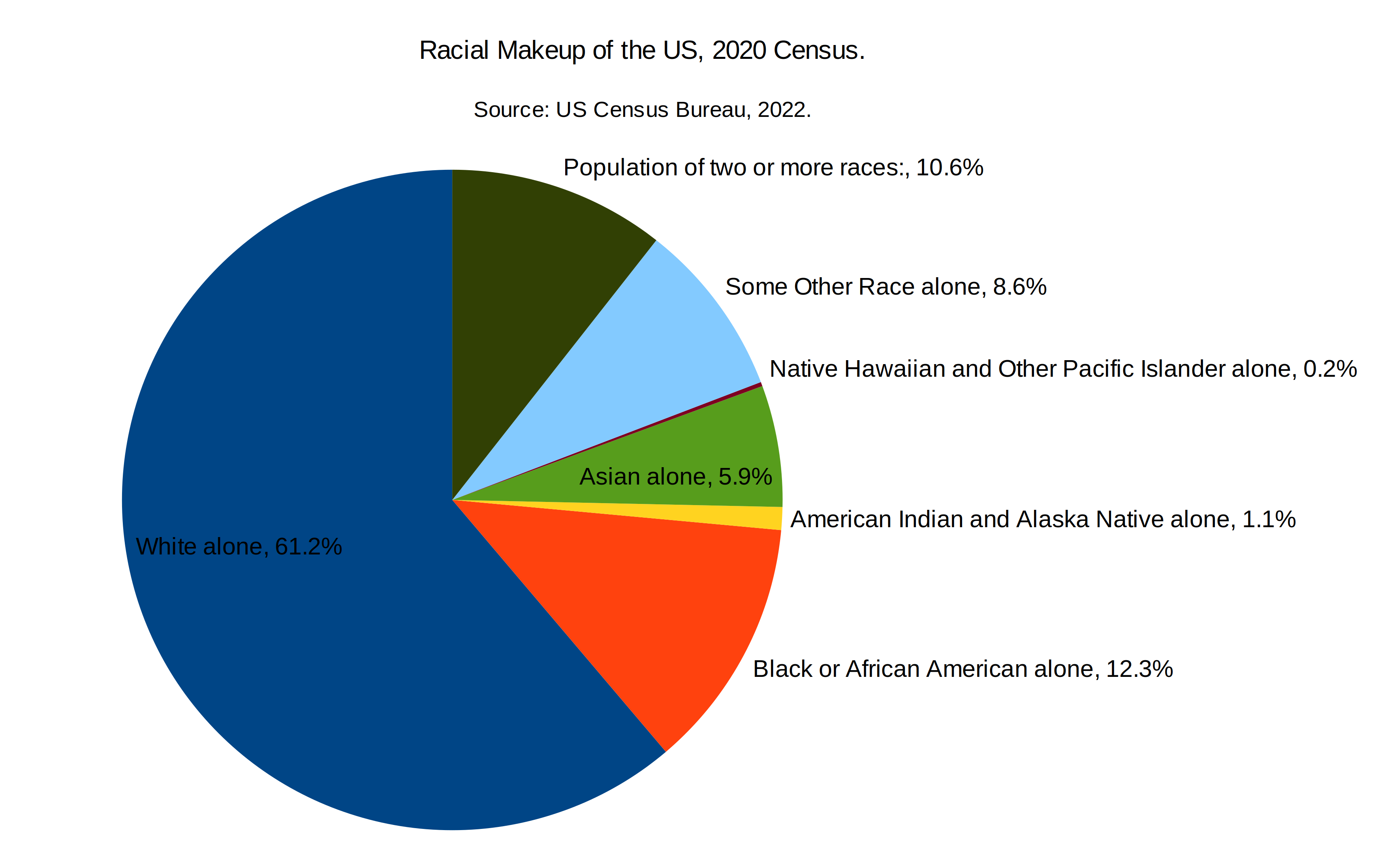 Primary Source: Chart
Primary Source: Chart
The ethnic breakdown of the US population as of the 2020 Census shows that the country remains a White majority nation, although predictions indicated that the White portion of the country will fall below 50% around 2050.
IMMIGRATION
Immigration has been an important part of the United States’ history, with many people from all over the world coming to the country to start a new life. Today, immigration is a major driver of demographic change. There are four main principles of American immigration policy. One is reunification, or to reunite families so they can live together in the US. Another is to admit immigrants with special skills to help fill job shortages and drive innovation. Protecting refugees who are fleeing from danger in their home countries is also important. Lastly, the diversity of admissions by country of origin is recognized as important for the melting pot of cultures in the US.
Mexico, China, the Philippines, India, the Dominican Republic, Cuba, and Vietnam are the leading source countries for legal immigrants. California, New York, Texas, Florida, Illinois, and New Jersey are the main states where legal immigrants go to live. Immigration has played a big role in the population growth of the United States.
Immigration has been an important part of our population growth. About one-third of all growth is because of people moving to the United States. Rules about who can come to the US legally have changed a few times over the years. In 1965, the Immigration and Nationality Act got rid of limits on how many people could come from each country which has led to much more diversity, especially in places where immigrants have settled.
People have strong feelings about immigration. Most people agree that we should let families stay together, welcome people with useful skills, help refugees, and make sure we have people from many different countries. But people don’t agree on how to make these things happen. Some people think we need more people to come to the US, while others think we need to be more careful about who comes. Immigration will probably stay an important topic for discussion and debate in the future.
 Secondary Source: Map
Secondary Source: Map
This map clearly indicates that immigration to the United States is now much more ethnically diverse than it was before the passage of the Immigration and Naturalization Act of 1965.
NATIVISM
In the history of the United States, immigration has been a big issue that has caused arguments and problems. Some people who are already here think they should have more rights than people who are new to the country. This is called nativism. In the past 30 years, there have been several times when nativism caused trouble in the United States.
One example of nativism in the United States was a law in California called Prop 187. It was made in 1994 and said that people who were in the United States without permission couldn’t use public services. This meant they couldn’t go to public schools, get non-emergency medical care, or use other services. In the end, Prop 187 was rejected in court and never implemented. But it showed that some people in California and other places didn’t like immigrants.
Another example of nativism in the United States became more common during COVID-19 Pandemic. Some people blame Asian Americans for the disease and attacks and prejudice toward Asian Americans has increased.
Nativism happens in other parts of the world, too, and sometimes it affects the United States. Far-right political parties in Europe and anti-refugee feelings in other places have inspired similar feelings among some Americans. Some of the things President Trump did, like the Muslim Ban, the wall on the border with Mexico, and separating families at the border, were criticized by some as nativist. Unfortunately, the Alt-Right Movement in America grew and became more public during Trump’s term in office.
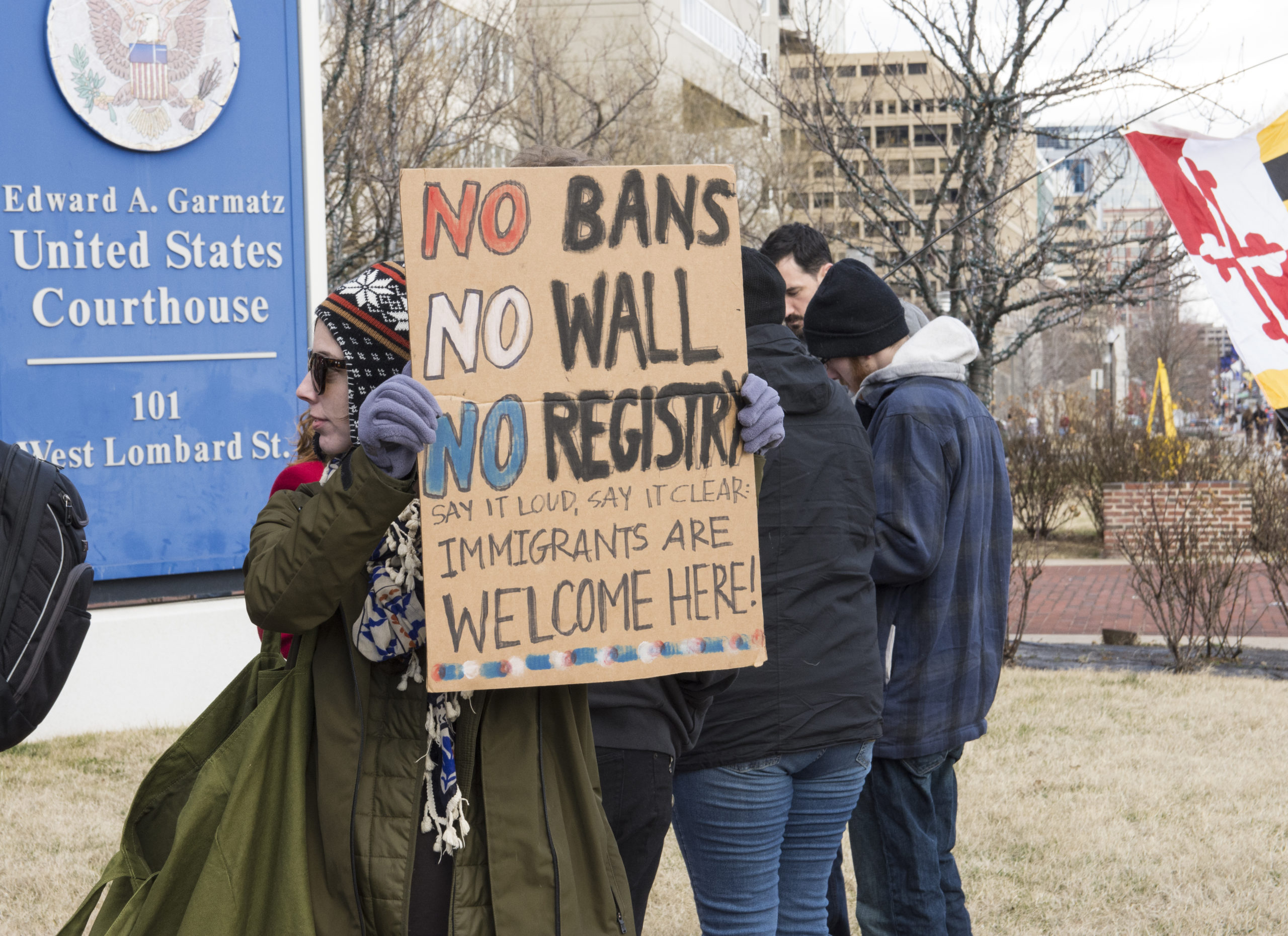 Primary Source: Photograph
Primary Source: Photograph
Demonstrators hold signs protesting President Trumps anti-immigrant policies.
INTERNAL MIGRATION
Internal migration is when people move within their own country. This has happened a lot in the United States. People move to different parts of the country to find better opportunities, better weather, or for other reasons. Some famous examples of this include the Okies in the 1930s and the growth of suburbs in the 1950s. Recently, a lot of people have been moving from the North to the South.
The Sunbelt is a region in the southern and western parts of the United States that has been growing over the past few decades. People are moving to the Sunbelt for jobs and better weather. Places like Florida and Arizona have warm climates that are attractive to retirees and others who don’t like the cold winters of the North. The growth of industries like technology and finance in cities like Austin, Texas, and Atlanta, Georgia, has also helped make the Sunbelt more popular. Phoenix, in Arizona, is the fastest growing metropolitan area in the country.
Some people, called Snowbirds, live in the North during the summer and then move south for the winter. Many of these Snowbirds are retirees or people with vacation homes.
Military bases are another reason people move within the country. Many bases are in the southern part of the country where there is no snow, which makes it easier for the military to operate year-round. The military is a big employer and where the bases are can have a big impact on local economies. Many service members and their families choose to stay in the area around the base after their service ends, which helps the population grow.
Changes in the economy, like factories closing in the Rust Belt, have also made people move southward for new opportunities that don’t involve manufacturing.
The shift in population from the North to the South has also changed politics. The South has traditionally been more conservative than the North and has more political power now. Southern states and leaders from the South are playing a bigger role in politics.
The Sunbelt has not only grown because of internal migration, but also because of immigration, especially from Hispanics coming north from Latin America. Sometimes people from the North and Hispanic immigrants have different values, cultures, and political opinions, which makes the Sunbelt one of the most politically dynamic regions of the country.
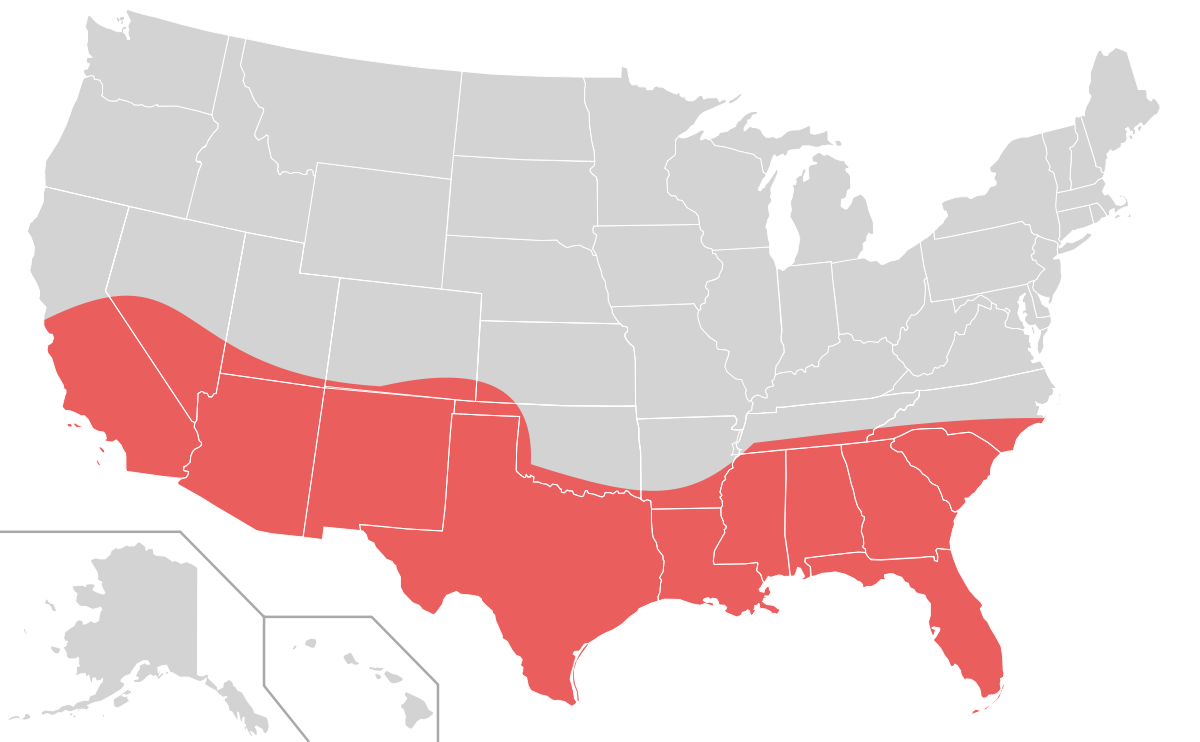 Secondary Source: Map
Secondary Source: Map
This map shows the area of the country often referred to as the Sunbelt. Warm and growing, the Sunbelt includes some of the nation’s fastest growing metropolitan areas such as Los Angeles, Phoenix, Oklahoma City, Atlanta and Miami.
THE BABY BOOMERS
The Baby Boomers are the generation of Americans born between 1946 and 1964. They’re the biggest generation in America up until that time, with about 76 million individuals. The Baby Boomers grew up during the 1950s and 1960s, which as you already know, was a time of enormous change in society.
The Baby Boomers had a big effect on American culture and the way society works. They were known for being optimistic and had big ideas for how things could be better. Many of them became leaders in movements for civil rights, against the Vietnam War, and for women’s rights.
At first, the Baby Boomers trusted and supported the government because things were going well. But during the 1960s and 1970s, that trust started to decline because of the Vietnam War, protests for civil rights, and scandals such as Watergate.
Some famous Baby Boomers who became leaders in politics include Bill Clinton and George W. Bush. In business, people like Steve Jobs, Bill Gates, and Oprah Winfrey became famous for their ideas and inventions and creativity.
As more people get older in America, there are now more and more people who are over 65 years old. This is happening because the Baby Boomers are starting to retire. In 2018, there were 52 million people over 65 years old in America, which is about 16% of the total population. By 2060, it’s expected that over 95 million people will be over 65 years old, which will be about 23% of the total population.
Because there are so many older people in America now, and because Americans are living longer than ever before, there are concerns about healthcare and social security. Some people call this situation the silver tsunami, in which the Baby Boomers will need many years of care, soak up government spending, and put a strain on the systems that care for them.
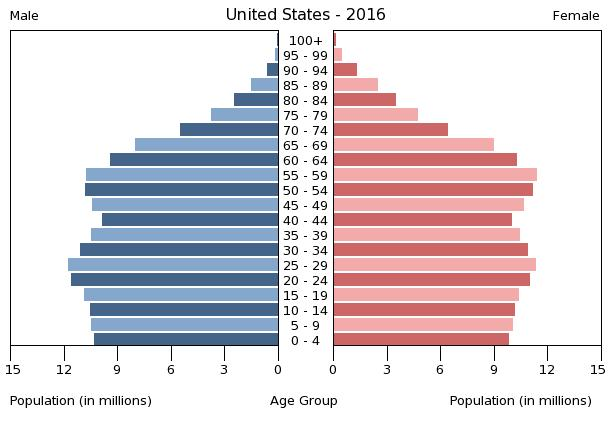 Secondary Source: Chart
Secondary Source: Chart
The population pyramid of the United States as of 2016. The Baby Boomers can clearly be seen as a bump in the population of people in their 60s on this chart.
GEN X
Gen X is the group of Americans born between 1965 and 1980. They are the last generation to be born before computers, cellphones, and the internet became common. This means that they grew up in a time when technology was very different from what we have today. As a result, they are able to see both the good and bad effects of technology.
Gen Xers are now in the middle of their working lives and may soon earn the most money they ever will. They were teenagers in the 70s and 80s when it became more common to have two working parents or be in a single-parent household. Many had to learn to be independent at a young age. This made them more independent and likely to question authority.
Despite this independence, or maybe because of it, many Gen Xers are becoming leaders in business and politics. Elon Musk, Mark Zuckerberg, and Jeff Bezos are examples of successful entrepreneurs from this generation.
MILLENNIALS
The Millennials, also called Gen Y, were born between 1981 and 1996. They are the first generation to grow up with computers and the internet, so they are comfortable with technology. Millennials became adults around the time of the new millennium, so they are often seen as optimistic and ambitious.
Millennials grew up in a much more diverse America than their parents and grandparents did. Because of this, they value diversity and are accepting of different backgrounds and cultures. Another thing that makes Millennials different is that they trust the government more than older generations. They believe in working together to solve problems and often get involved in politics. Some of the most dynamic politicians today are of this generation.
Many millennials graduated from college during a tough job market and struggled with financial insecurity. Despite these challenges, they are known for their positive attitude toward business and their determination to achieve their goals.
GEN Z
Gen Z, also known as Zoomers, were born between 1997 and 2012. For women of this generation education and career advancement are often priorities before starting a family. For the first time ever, the average age when women have their first child has risen to 25.
Gen Z grew up during times of social and political upheaval, including the COVID-19 Pandemic. Despite this, Gen Z is optimistic about the future and has been actively involved in social justice movements like Black Lives Matter and environmentalism.
Gen Z is proficient with technology and unlike the Millennials, Gen Z grew up with social media platforms like TikTok and Instagram, which have shaped their worldview. They are outspoken and passionate about issues like LGBTQ rights and have been advocates for equality.
This generation is also focused on emotional intelligence and mental health, making them one of the most empathetic and compassionate generations. They have produced prominent figures such as Greta Thunberg, Simone Biles, and Billie Eilish.
Although Gen Z are growing up into a world of challenge and uncertainty, they have the potential to become one of the most influential and intelligent generations in history.
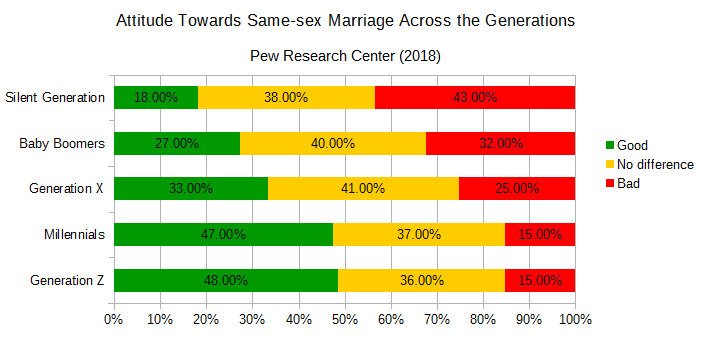 Secondary Source: Chart
Secondary Source: Chart
The youngest generations of Americans have had a significant impact already on social policy, especially surrounding acceptance of LGBTQ Americans.
GENERATION ALPHA
Generation Alpha, the generation after Gen Z, includes those born from 2010 to 2025. They are the children of Gen X and Millennials and are often called digital natives because they grew up in a world where technology is everywhere. This generation is comfortable with technology from a young age and is more tech-savvy than any generation before them. Many are learning how to use mobile devices and apps before they learn to read.
We do not know what the future holds for Generation Alpha because they are still very young. However, as they grow up, we may see some of their unique characteristics become more apparent. It will be interesting to see how they navigate a world that is constantly changing and evolving. While we cannot predict their future, we know that technology will continue to play a significant role in their lives.
CONCLUSION
As a group of people, we Americans are constantly changing. Our population is becoming more diverse and more mixed. We are living longer, but as the older generation retires and younger people become leaders, our ideas and beliefs are changing too. Our population is also moving south, which will have an impact on our politics and culture. As we look to the future, we should take a moment to think about who we are now and who we will become in the years to come.
Who are the Americans?
CONTINUE READING
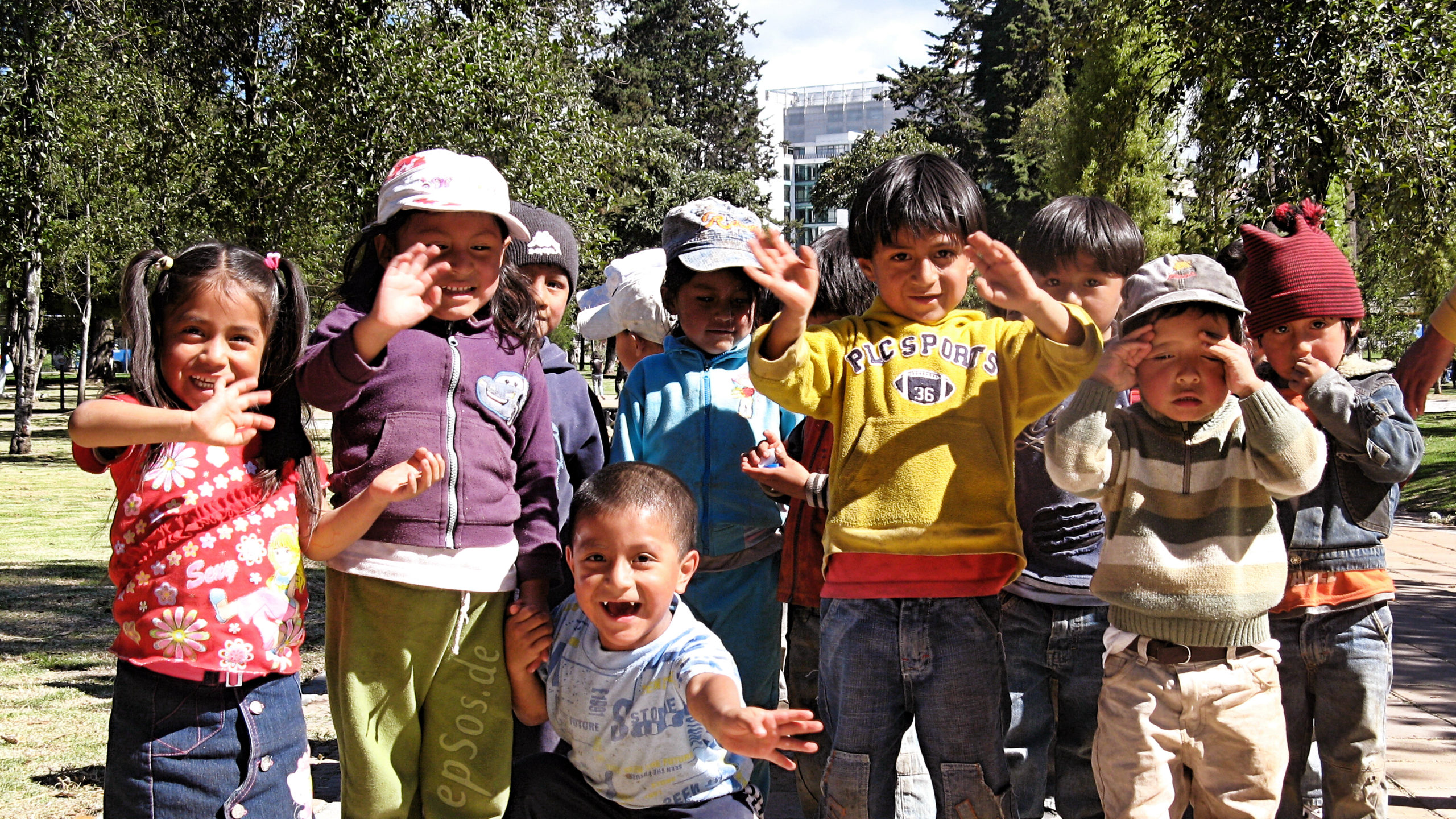
SUMMARY
BIG IDEA: The population of the United States is undergoing significant change. Since the 1960s, immigration and internal migration from North to South have reshaped the ethnic makeup and distribution of our population. The country is projected to be a majority-minority country by 2050. That change, along with new values held by younger Americans who are digital natives and the retirement of the Baby Boomers will have significant impacts on the culture and politics of the country.
Immigration continues to play a significant role in demographic changes. Since 1965, immigration policy has favored family reunification, admitting immigrants with special skills, protecting refugees, and promoting diversity.
Immigration remains a politically divisive issue. Nativists have promoted anti-immigrant policies such as Prop 187 in California which, had it passed, would have prevented undocumented immigrants from attending school, and the recent rise in anti-Asian hate crimes during the COVID-19 pandemic are examples.
Internal migration has also reshaped America. The growth of the Sunbelt is being driven by warmer climates, new job opportunities, snowbirds, retirees, military bases, and job losses in the Rust Belt. The increase in population in the South has also led to political and cultural change.
The Baby Boomers, born between 1946 and 1964, grew up during a time of social and political change, with many joining the civil rights, anti-war, and feminist movements. They are skeptical of the government after living through the Vietnam War and Watergate scandal. As they retire, there are growing concerns about the strain this unprecedented number of aging Americans will place on the healthcare and social security systems.
Gen X, born between 1965 and 1980, is the last generation of Americans to grow up before computers and cellphones were common. Known for their independence, self-reliance, and tendency to question authority, Gen X is poised to take over leadership of the country as the Boomers retire.
Millennials were born between 1981 and 1996 and are considered to be the first digital natives. They value diversity and inclusivity and express confidence in the federal government’s ability to solve problems and are often politically engaged. Despite growing up in challenging economic times, they are known for their positive attitude toward business and their drive to work toward achieving their goals.
Gen Z, born between 1997 and 2012, are technologically savvy. The COVID-19 pandemic has had a significant impact on their lives, but despite the challenges, they remain optimistic about the future and are active in social justice movements. Gen Z is also a generation that is outspoken and passionate about issues such as LGBTQ rights and mental health.

VOCABULARY
![]()
PEOPLE AND GROUPS
Refugee: A person who has to leave their home to escape persecution, war, or violence.
Snowbirds: Retirees who live in the North but spend their winters in Florida or other southern states.
Baby Boomers: Americans born between 1946 and 1964, during a period of high birth rates in the United States. They came of age during the 1960s and 1970s and make up the bulk of America’s retirees.
Gen X: The generation of Americans born between the mid-1960s and the early 1980s. They are now at the prime working ages of their lives and are emerging as the nation’s leaders. They were the last generation to grow up before computers and the Internet are common.
Millennials: The generation of Americans born between the early 1980s and the mid-1990s. They are now young adults and are the first generation to grow up with computers and cell phones.
Gen Z: The generation of Americans born between the mid-1990s and the mid-2000s. High schoolers today are part of this generation.
Generation Alpha: The generation of Americans born after 2010. The term is still relatively new and is used to describe the children of millennials and Gen Zers.
Digital Natives: People who have grown up using digital technology, such as computers and smartphones, from a young age. The term is often used to describe millennials, Gen Zers, and members of Generation Alpha.
![]()
KEY IDEAS
Minority-Majority: A situation when the largest group within a population makes up less than 50% of the overall population. By 2050 Whites, currently the majority of Americans, are expected to make up less than 50% of the total population making the United States a majority-minority country.
Reunification: A policy of allowing immigrants to come to the United States if they already have family members legally living in the country. The policy is aimed at keeping families together.
Nativism: A belief that people born in the United States are superior to immigrants.
Alt-Right Movement: A movement of various far-right groups that emphasizes white nationalism and anti-Semitism. These groups have grown in public exposure during the presidency of Donald Trump..
Internal Migration: The movement of people inside a country from one region to another.
Silver Tsunami: A term that describes the aging of the Baby Boomer generation and the impact that this will have on society, such as on healthcare and other social services. It has been criticized as being ageist.
Border Wall: A nickname for the physical barrier along the U.S.-Mexico border that was a key proposal of candidate Trump during the 2018 presidential election.
![]()
LOCATIONS
Sunbelt: A region in the southern and southwestern United States that has experienced significant population growth in recent decades. The region is known for its warm climate and economic opportunities.
![]()
LAWS
Immigration and Nationality Act of 1965: Major revision to immigration law passed in 1965 that eliminated national quotas and instead encouraged family reunification. It led to a tremendous increase in immigration from Asia, Latin America and Africa.
Prop 187: A 1994 ballot initiative in California, which would have stopped undocumented immigrants from being able to use some public services including education and healthcare. An example of nativist sentiment, the proposal was controversial and did not pass.
Muslim Ban: Nickname for Executive Order 13769, which was signed by President Donald Trump in 2017. The order restricted entry into the United States for citizens of seven Muslim-majority countries and was widely criticized for being discriminatory.
